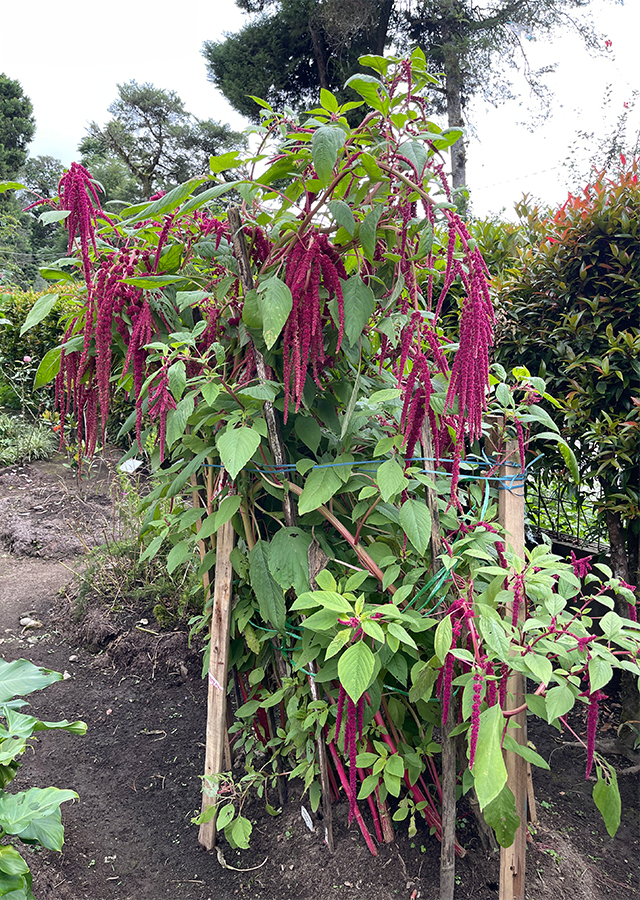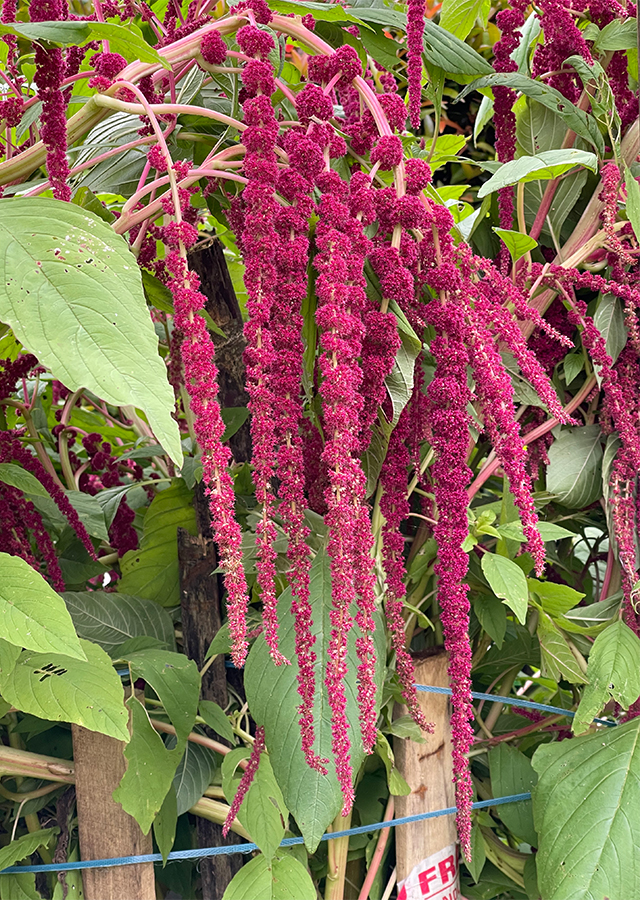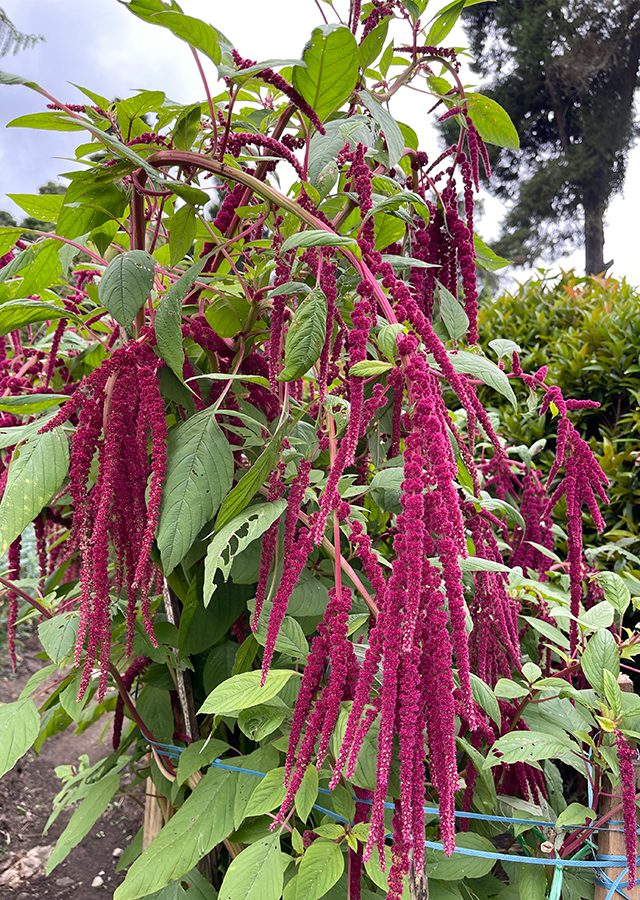Foxtail Amaranth
Amaranthus caudatus L.
Amaranthaceae
Location in our garden
Principal



Synonym
Amaranthus abyssinicus L.H.Bailey
Amaranthus edulis Speg.
Euxolus arvensis Rojas Acosta
Habitus
Herbaceous. Herbaceous plant, annual, upright, grows 50 - 200 cm tall.
Part Used
The Whole Plant
Growing Requirements
Full Sunshine
Habitat
Terrestrial
Overview
Amaranthus caudatus is an herbaceous plant that is generally believed to originate from Central to South America. This species is one of the most popular domesticated amaranths and is cultivated primarily as an ornamental plant, also widely used as a source of food, alcoholic beverages, bread, nutritious vegetables, and dyes. In South America, amaranths is used traditionally in medicine, where the roots, leaves and seeds are believed to be a natural medicine that is good for health. A number of studies also state that this plant contains high levels of antioxidant compounds.
Vernacular Names
Mosca de pavo (Spanish), Amarante des jardins (French), Lao qiang gu (Chinese), Fuchsschwanz- Amarant (German), Amaranto codato (Italian), Sennin-koku (Japanese).
Agroecology
Amaranthus caudatus is a tropical plant, although it can be cultivated from tropical to temperate regions. It grows best where annual daytime temperatures are in the range of 21 - 28 °C, but can tolerate 7 - 40 °C. Can die at 4 °C or below. Thrives on fertile well-drained soil in a sunny position in full sun but can tolerate a wide range of conditions, both damp and dry. In East Africa, it is found at an altitude of 500-2500 m above sea level, in South America at an altitude of 1000-3200 m above sea level. A. caudatus prefers average annual rainfall in the range of 800 - 2,300 mm, but tolerates 250 - 4,200 mm, and can grow in sandy and clay soils. This species is drought tolerant although reasonable humidity levels are required for germination and also during pollination. Prefers a pH in the range of 5.5 - 7.5, tolerates 4.3 - 8.5, can tolerate mild salinity. It can also tolerate acidic soil and aluminum toxicity.
Morphology
- Roots - long tap roots, white, pinkish flesh.
- Stems - erect, round in shape with a smooth and slightly grooved surface, monopodial branching, and yellowish green or purple in color.
- Leaves - single, long-stemmed, arranged alternately, leaf blades ovate, rhombic to oval, blunt to subacute at the apex, short tip at the base, hairy, leaf edges flat to wavy. The leaves are purplish-green, the spines are pinnate.
- Flowers - small, clustered, compound, appearing in the axillary or terminal. Panicle-shaped inflorescences are red. The petals are divided into five and are oval in shape, the stamens are five, the pistils are 2-3, and the crown is purplish green.
- Seeds - small and round or oval in shape, shiny black in color.
Cultivation
- Plant propagation using seeds. Can be sown in place or in a nursery and then moved to its permanent position 2 - 3 weeks later.
- Germination increased with increasing temperature in the range of 5-35 °C, and no germination occurred at 0 °C. Seedlings usually appear 3-5 days after planting, where initial growth is usually slow.
- Plant propagation can also be done through cuttings.
Chemical Constituents
Phenolic acids, lycopene, polyphenols, unsaturated fatty acids, glucosinolates, soluble peptides, squalene and beta carotene, ferulic acid, caffeic, betalain, amarantin, amaricin, carotenoids, lectins, lignin, flavonoids (such as nicotiflorin, isoquercitrin, quercetin,rut, kaempferol), gallic acid, salicylic acid, chlorogenic acid, gentistic acid, ferulic acid.
Traditional Medicinal Uses
- Functions as a laxative.
- Treats eye diseases, amoebic dysentery, wounds.
- Prevents the growth of cancer cells, atherosclerosis (narrowing of blood vessels due to fat buildup).
- Lowers cholesterol levels.
- Protects heart health.
- Reduces the risk of liver inflammation.
- It has activity as a diuretic, astringent, anthelmintic, antioxidant, antimicrobial and antidiabetic.
Part Used
Reference Sources
- CABI Compendium. 2015. Amaranthus caudatus (love-lies-bleeding). https://www.cabidigitallibrary.org/doi/10.1079/cabicompendium.4642. 27-01-2024.
- Tropical Plants Database, Ken Fern. Amaranthus caudatus. https://tropical.theferns.info/viewtropical.php?id=Amaranthus+caudatus. 27-01-2024.
- IPBiotics - View TumbuhanObat
- Bayam Kastoyan : Manfaat - Efek Samping dan Tips Konsumsi - IDN Medis




